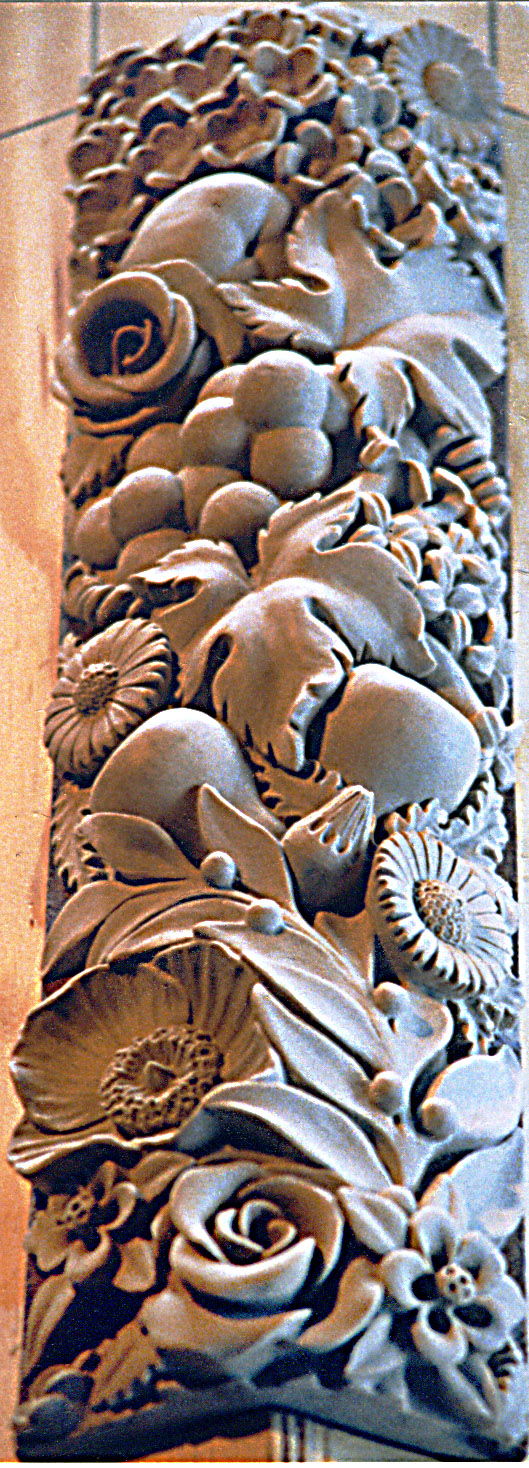
Architectural Ornament
The basic traditional forms of architectural ornament began as representations of mankind's natural environment millennia ago. They've been borrowed, varied, and combined from culture to culture around the world ever since, creating a rich vocabulary with more archetypal symbolism than you can shake a stick at. It is a field I love with all my heart and consider myself immensely lucky to work in.

Cartouche
Created for Hytla & Hart, 1980s.

Upsized Ceiling Rosette
Created for Monumental Plaster Moulding, 2010s. An up-sized variation on an existing design.

Art Deco Rosette
Made at MCMC in the '80s. My inimitable Dutch boss wanted an art- deco-style motif of people. Wagging his finger at the circular base, he said it should go "mahn and vife, mahn and vife, mahn and vife...". I still hear him saying it every time i look at this rosette.

Roses
Created at MCMC, 1980s. Many many castings of this cluster of roses now adorn the National Theater in Washington, DC, high on the walls by the ceiling.

Leaf and Bellflower Rosette
That’s me in the 1980s, working at MCMC. The leaves in the upper photo are cast in wax from a mould of my flat clay models. 8 wax sets were bent to fit the curves of the plaster base. The lower photo is the finished rosette.

Fruit Arch
Created for MCMC, for a gorgeous kitchen in a private home.

Shell and Linking Leaves Crown Molding
Created for MCMC in the ‘90s.

Flowers and Fruit Ceiling Molding
Created for MCMC in the 1990s, for a mansion in Florida. Many yards of this moulding were painted by hand in multiple colors (though not by me) and installed on the ceiling of a huge room.

Flowers and Fruit Ceiling Molding
Created for MCMC, 1990s, for a mansion in Florida. Many yards of this moulding were painted by hand in multiple colors (though not by me) and installed on the ceiling of a huge room. Making this model was a treat!

Acanthus Leaf and Flower
Made for MCMC, 2000s.. Models for elements of a rosette.

Modified Caryatids
Made for MCMC, late ‘80s, for a hotel restaurant in Montreal. I was given two concrete figurines vaguely similar to the designs desired. Both required a whole lot of chiseling before rebuilding with clay. Somebody thought the figurines would save time. Nope!

Flowerbud Ceiling Element
Made for Hytla & Hart, 1980s. Two castings of this delicate pattern were used to bracket a ceiling rosette.

Scroll Sequence
Made for MCMC, 2000s. A series of pics showing the model in stages of creation. Oil-clay doesn’t stick easily to some surfaces, so I firmly smoosh a thin layer of clay onto the entire surface first. Then it’s easy to position the parts anywhere.

Corner Leaf
Made for MCMC, 2000s. These clay leaves, like many corner elements, can be cast separately from thee rest of the crown moulding they are made to fit,, and affixed on site after the moulding is installed.

Leaf-&-Tongue Capital
Made at MCMC, 1980s. Originally made as one piece with a tall pillaster, later turned into a very bold base for a glass-top table. That’s young me in the picture, with the clay prototype tongue I later made the acanthus leaves on top of the assembled tongues.

Two Scallop Shell Motifs
Made at MCMC, 1980s. These would be used at focal points, like the center of a wall. The moulding underneath each one would be used without these shell designs in the rest of the space room.

Art Deco Rosette
Made at MCMC, 1980s. My inimitable Dutch boss wanted an art- deco-style motif of people. Wagging his finger at the circular base, he said it should go "mahn and vife, mahn and vife, mahn and vife...". I still hear him saying it every time i look at this rosette.

Upsized Ceiling Rosette
Created for Monumental Plaster Moulding, 2010s. This shows both the smaller antique version (top), and my much bigger copy (cast in two halves.) The new one was for a very high ceiling, where the details had to be more dramatic to be visible from below.

Four-Repeat Rosette
Made for MCMC around 2000. The lower shot is the clay prototype from above. The upper shot is of four castings of the ¼ prototype assembled and joined seamlessly, ready to have the final mould made.

Tiny Capital
Made at MCMC, 1980s. Two castings from this first rubber mould made one whole capital. Originally made for each of many displays in an upscale retail store, a drawing of it was later used in the logo of MCMC. That’s a men’s wristwatch to the right, for scale.

Two Elegant Crown Mouldings
Made at MCMC, 1980s. It was a special pleasure to make the models for these exquisite mouldings designed by the very talented Daniel Bui.




















